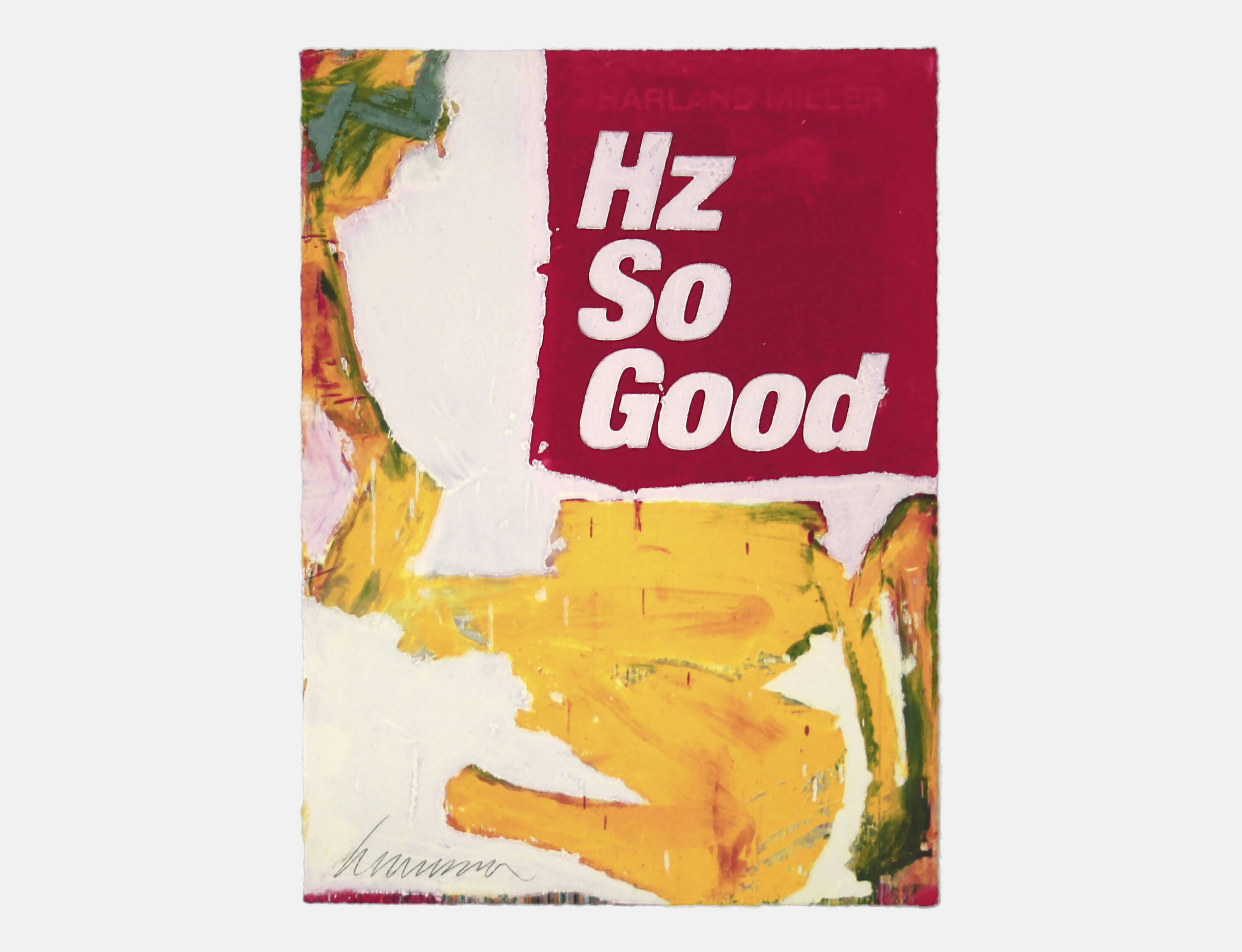
Harland Miller: 'I've always loved high and low culture. This painting perfectly encapsulates both, more than any painting I've made.'
The artist tells us all about his new Phaidon & Artspace limited edition, Hz So Good, 2022
In 1982, having left school a couple of years earlier as an ‘Easter Leaver’, Harland Miller was serving an apprenticeship at Priestly’s, a T-shirt printer in York, in the north of England.
The shop made many bootleg band T-shirts, often with their name slightly altered to avoid copyright infringement. It’s unlikely that John Cougar Mellencamp – enjoying a big hit at the time with Hurts so Good - was one of the artists singled out for artistic immortality by the fledgling painter, but forty years later, Miller used the title of Mellencamp’s hit single as the jumping off point for a new painting, Hz So Good, which is released by Phaidon & Artspace as a limited edition print today.
The edition comprises 100 copies of an etching with letterpress relief printing. Sheet size: 31.9 x 22.4 cm (12 9/16 x 8 13/16 in). It is signed by the artist on the front, and numbered on the reverse.
Just a year or two after his spell in the T-shirt shop, Miller started an undergraduate Fine Art degree at Chelsea School of Art, London, an institution more focused on painting than other London art schools at the time. The rest, as they say, became history. You can purchase the latest part of that history here. Meanwhile, here's Harland to tell us more about it.
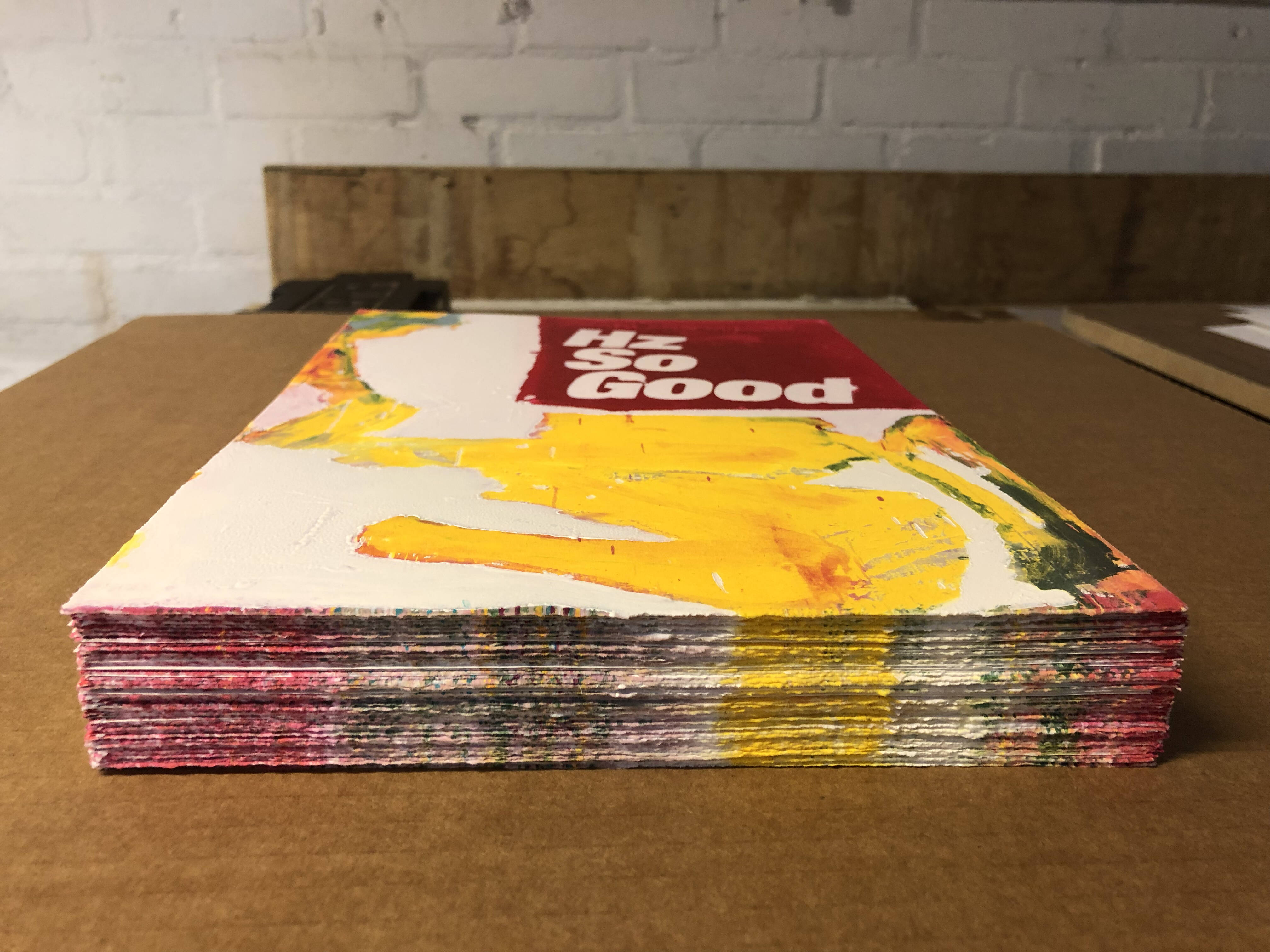 Hz So Good, 2022
Hz So Good, 2022
Tell us more about the title and what it means. We know Heinrich Rudolph Hertz was the man who discovered electro-magnetic radio waves and who the unit for measuring frequency is named after, but is there more we should know? Sure yeah, the title yeah - it came to me while listening to the song of the same name, Hurts so Good by John Cougar Mellencamp. I've always been lyrically orientated and in fact I can actually enjoy songs I don't even like musically, if the lyrics appeal. In fact I’d go further and say that I can even enjoy the lyrics of songs that I don't particularly like even if I don’t, in fact, like the lyrics but they strike me in a certain way and stay with me.
That's what music can do - y'know it’s the most abstract thing ever. Sometimes I feel capable of all sorts of things when I’m listening to a certain song that I immediately no longer feel capable of the second the song finishes. Sometimes in the silence that follows, an aspect of the song hangs on - even persists -not always but it’s usually the chorus, disembodied from the verses.
Over time, it can come to mean something entirely different, something personal, but you still can’t use it in your work because it's somebody else's. These permutations aren't scientific of course, but I remember really liking the sort of semantic connection between radio waves and the scientific symbol in this context of Hz as a different way of saying Hurts. And y'know that was a way I saw of riffing on this title.
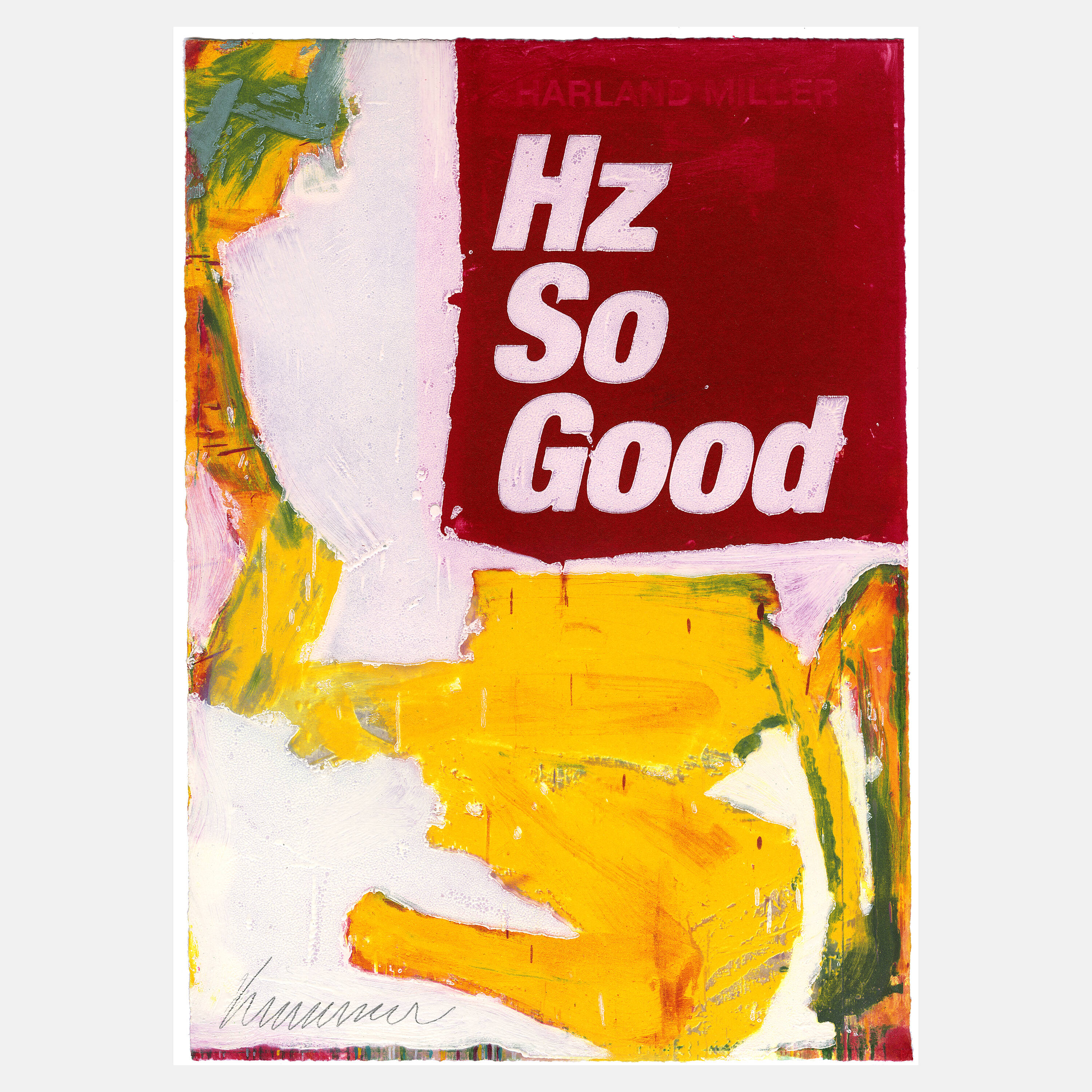 Hz So Good, 2022
Hz So Good, 2022
What were you trying to convey when you made the original artwork from which this edition is taken? What do you remember of the time? What was I trying to convey? Uhm, well I’ve touched on this in the answer to the previous question, I think. But you know - just as an asides, I’m always thrown by the way questions - and my answers - about what I’m doing are often phrased that way, y’know, in terms of what I thought I was doing. Like, ‘What were you trying to convey?’ It kind of makes me think that whatever it was it obviously hadn’t quite succeeded! Ha!
You could probably put it down to paranoia, it’s like my subconscious hears that word trying, gears down, and is rapidly going past ‘What were you tranna do?’ - to - ‘What were you thinking of.’ - to - ‘What were you playing at Harland?’ And in a way this is taking me to the heart of it, as I’ve been thinking a lot lately about whether it's OK to play with the idea of not thinking about what I’m doing. Not to negate thought, but more to allow the subconscious to take over and riff on the ideas that are being suggested by the title, in that Jungian way y’know.
You recently created an edition to benefit the ICA. How do you view editions within your practice and what role do they play? Yeah, I did this Triple X print for them, XXX partly because I used to be the writer in residence there. I took over from Zadie Smith who’d revitalised the role and because of its history. It was a scene, a place where young writers, like Zadie, and film makers, musicians, performance artists, painters, potters, and curators and impresarios of all stripes converged. Even people who stuff animals, what are they called- taxidermists all came together there! And I’m really going the long way round here trying not to use the very unlovely but much used phrase, ‘interdisciplinary’ which always breaks down in my ears as ‘Into-discipline-are-yee?’ Like I’m into discipline – because y’know, I’m not!
I understand the context of course I do, and I understand rigour and discipline but I don’t want those descriptions to remind me of the effort that’s gone into making something - that just drags it down. But going back to your question I see that printmaking is one of the disciplines I’ve actually missed out in my above list, which is very telling I think, because there is a perception of printmaking as being about things like mezzotints, linocuts and etchings - the latter of which y’know, has its own unfortunate connotation with not particularly grand attempts at seduction - whereas I’ve always thought of print as very heroic.
I mean I started out as a print maker - well more of a bootlegger really - which is admittedly less heroic, but still not lacking in excitement, and all very far away from the dusty portfolios of print dealers.
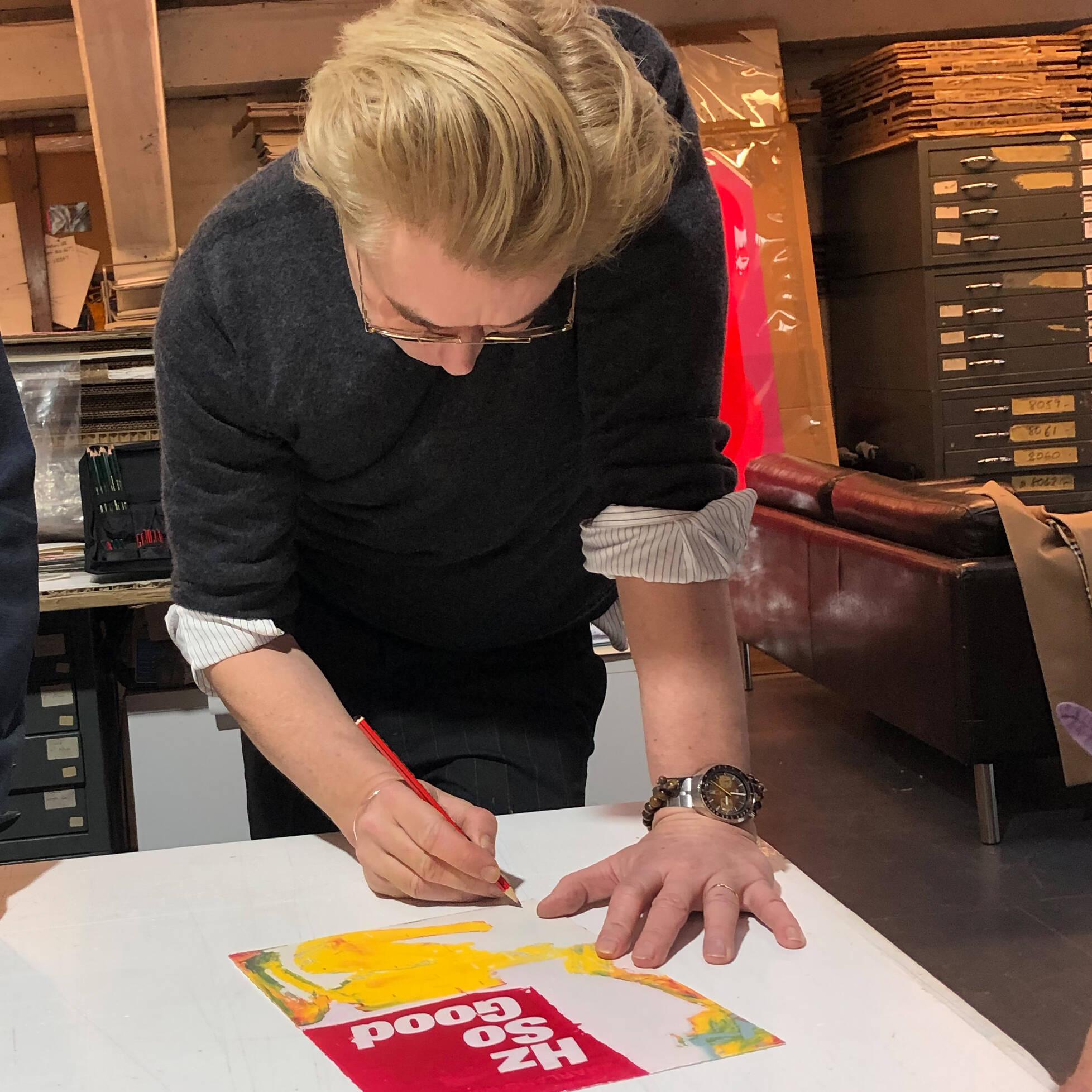 Harland Miller signing the edition
Harland Miller signing the edition
But look y’know, a lot of my work has been inspired by print and print making. I have to say I wasn’t a very good printmaker - technically - and perhaps consequently I got to love the imperfections of print: the mistakes, the mess! I’m very inspired by Warhol, and Warhol was very obviously inspired by imperfect colour plate registration, and he took that and exaggerated it on, I think it can be said, a heroic level! I’m also a bit of a pop artist - of course I am - and as such I really love and revel in repetition.
Revel in it? That’s maybe taking it too far, but I love the power of repetition which is such a part of print making and what I also love about it is it stops! Y’know, it’s a run, and the run stops, its finite. But any collector will tell you how tantalising and exciting that is, numeration I mean. Don DeLillo goes into this a lot more eloquently in his novel Underworld, he devotes a whole chapter to it. It’s kind of an underlying theme.
What do people who buy your paintings and editions say to you about them? Is there a thing they see that critics and artistic contemporaries maybe miss? Hmm, well yes there is but I wouldn’t say it’s something missed by critics and contemporaries, as much as something unknown - something that they could never be expected to know - so it’s not a thing - it’s some thing! Something that’s personal to the collectors you referred to and obviously, that’s as varied as it gets. I mean people have let me in on some incredible stuff - secrets really - yeah, secrets, as such I can’t say what they were here - not the specifics anyway and yet I find people really want to tell me what a particular work means to them, and sometimes not just me, they want to tell the whole world.
For them, it’s like a maxim or mission statement, and the stories behind them can be so elaborate. One guy told me he literarily had the PLAN B (my story) hung on the wall behind his desk, because he said, while hiking his thumb over his shoulder, ‘I knew I was gonna get fired. So when they came in, I was all ready for ‘em!’
That’s one story but I was recently told another in the opposite direction, a very shy guy – at least he was shy when he was telling me this - said that all my works meant something to him. And not just him. He was gay, but not exactly out to his family, for whom it wouldn’t have been cool apparently. So he and his partner had encoded the titles in the works to mean something else ,something specific to them that only they understood about their love. Each title had a cypher, both of which were committed to memory so that in a situation where they couldn’t easily express themselves they instead spoke about my work. It’s beautiful - and practical!
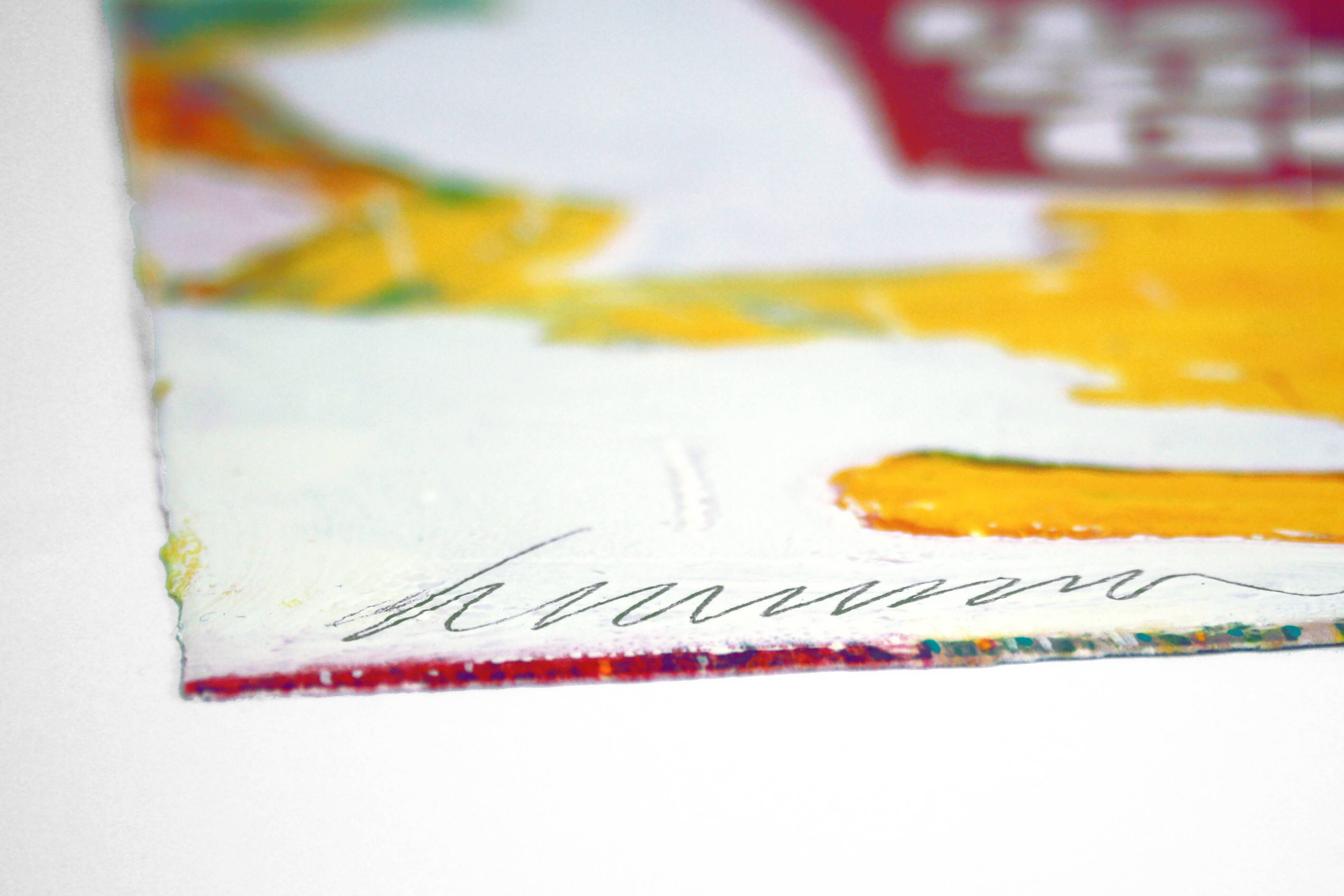
Hz So Good, 2022
You’ve gone through a number of changes in your practice, what do you think will be the next one? That’s quite relevant in so far as this print Hz So Good is concerned as it’s very associated in my mind with breakthrough works, by which I mean a work that I’ve made in my studio that will, in time, become the first example of what will, by then, be known as a new series. That sounds a bit convoluted, but what I mean is that while there are obvious works that relate to this painting, like ‘UP AS A SUPERPOSITION’ I relate it more to other breakthrough works; probably a known example would be the very first Penguin book painting I ever made in 1992 in Paris, I’m So Fucking Hard Ernest Hemingway.
For me, this Hz So Good has more in common with that Penguin painting than other works in this series. This series that riffs on scientific language - I call them the Scientific term paintings. Catchy right? But to your question what’s actually next, I always work on several series simultaneously, so it’s not one thing after another.
I’ve just had a show with my gallery White Cube, in Bermondsey and there was a painting in the 9 x 9 gallery called Painting for a public sculpture. This was one of the last paintings I made for the show, and I think it's conversely going to be the first of a new series of more abstract letter paintings that have a sense of being figured in landscapes. And this series is prosaically titled ‘Paintings for Public Sculptures’.
If I buy this edition what’s the smart thing to say to friends when they admire it? What do you mean if you buy it! Well OK, let’s assume you have acquired one and its framed and up on your wall, and assuming that people are actually admiring it, you can, as we mentioned above talk about what it means to you personally - you could ask them what, if anything, it means to them, you could put on the actual record by John Cougar Mellencamp - or you could talk about Heinrich Rudolph Hertz and electromagnetic radio waves and the abbreviation of his name to Hz being the unit for measuring frequency - or you could discuss both.
I’ve spoken in the past about how I’ve always loved both high and low culture separately - but also when they come together - which isn’t often, but it’s something I’ve tried to evolve in my work, and I think y’know, I think I can say that this painting perfectly encapsulates both, perhaps more than any other painting I’ve ever made.
You can purchase Hz So Good, 2022 here.